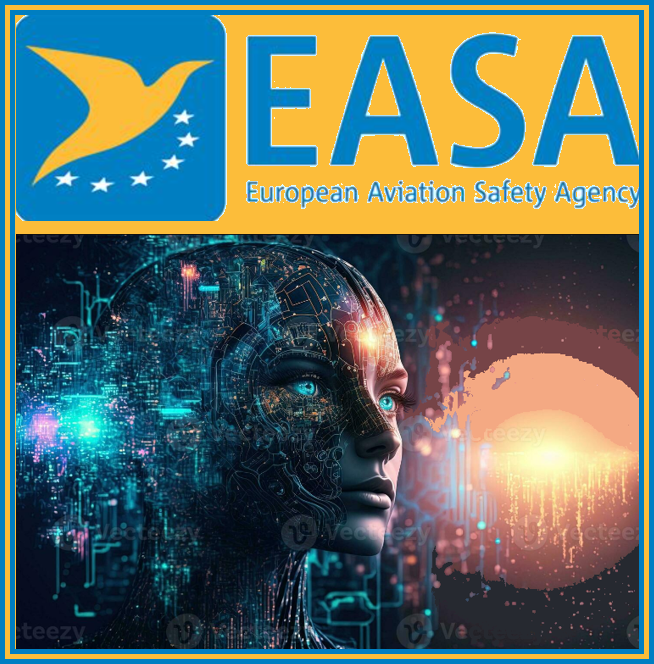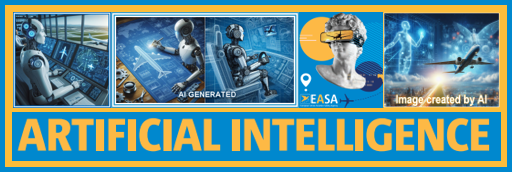ARTIFICIAL INTELLIGENCE, we all know, is COMING to AVIATION, soon, but WHAT WE ALL DO NOT KNOW, is exactly what it can, cannot, should or should not do. As a consequence of this rapidly emerging technology, many of us feel like the six blind people trying to define this large UNKNOWN, CONSTANTLY ADAPTING AND RE-ADAPTING TECHNOLOGY.

EASA has been issuing a series of informative papers which collectively are setting SOME DIMENSIONS TO WHAT AI MAY BRING to aviation. The words used are not in absolute terms, recognizing that the dynamic, iterative progress may continue in the DIRECTIONS IDENTIFIED, but with doubts as to how far this development may go or what mutations may appear along the way.
The insights are organized under eight categories:
- Flight operations
- Maintenance
- Environment
- Air traffic management
- Airports
- Drones and innovative air mobility
- Cybersecurity
Each paragraph contains several nuggets of what might work in each of these aspects of aviation. Not yet a precise roadmap, but it portrays a graph as useful as the early projections of the sky’s celestial array.
THANKS EASA.

++++++++++++++++++++++++
Artificial Intelligence and Aviation

Artificial intelligence (AI) is set to play a role in all aviation domains. Introducing such technology will enable advanced assistance to aviation professionals and process optimisation in ways otherwise not possible, allowing for an even safer and more sustainable aviation sector.
Naturally, new technologies come with risks and challenges, for example, the complexity of machine learning systems, the ethical implications and cybersecurity of AI systems. Through its ARTIFICIAL INTELLIGENCE ROADMAP, EASA is committed to ensuring that the aviation industry benefits from the potential of integrating artificial intelligence in its operations, while maintaining the highest standards of safety and environmental protection.
How can artificial intelligence applications bring benefits to aviation?
One of the great powers of artificial intelligence is the ability to process vast amounts of data and learn from them. Such abilities can be used for detecting patterns, developing predictions and anticipating risks and can have a positive impact on different domains in aviation, as you can see in the examples described below.
Flight operations

Artificial intelligence may assist the crew by advising on routine tasks to enhance the operational efficiency of the flight. It can PREDICT issues like TURBULENCE AND ICING conditions and help the pilots in decision making when faced with a conflict.
Maintenance

With digitalisation, the amount of data handled by production and maintenance organisations is growing and with this, the NEED TO RELY UPON AI TO HANDLE THIS DATA IS ALSO INCREASING. AI-based predictive maintenance can assist in optimising maintenance schedules, predicting remaining useful life of parts and therefore preventing failures.
Environment

Among others, the optimisation of flight trajectories is one example of how AI can HELP REDUCING CARBON EMISSIONS during flight operations.
Another example where AI support will be valuable is on impact assessments. Assessing the environmental impacts of aviation, such as noise around airports or in-flight engine emissions, is a data and computation-intensive activity. AI can make it possible for EASA to improve its capability to deal with such data.
Air traffic management

By analysing data on weather patterns, sectors configurations, air traffic congestions and other factors, artificial intelligence could support the optimisation of flight routes, reduce flight time, fuel consumption and costs. Such an optimisation would then lead to a more efficient air traffic management system, reducing delays and increasing the capacity of air travel.
Artificial intelligence and Machine Learning (ML) applications can also help Air Traffic Controllers to make more informed decisions and faster, when faced with a conflict.
Airports

On the air operations side, artificial intelligence can support in the detection of foreign object debris on the runway and unlawful unmanned aircraft (like drones) in the surrounding of airports, as well as support in the prevention of bird strikes.
Inside the airport terminal, AI can assist in security screening, detection of dangerous goods and surveillance.
Drones and innovative air mobility

As we move towards a reality where air taxis are not a thing of science fiction, and unmanned aircraft like drones are more robust and used for multiple purposes, the airspace is set to become more crowded.
Artificial intelligence will then be crucial for the integration of manned and unmanned aircraft, while ensuring a safe sharing of the airspace between users, and ultimately, the implementation of advanced U-space services (in short, U-Space is a set of solutions to manage unmanned aircraft traffic). This can include things like: detecting obstacles, allowing for change of trajectories and assessing risks on the ground when landing.
Cybersecurity

Artificial intelligence can support in creating more effective and robust systems to prevent cyberattacks. It can be used for automatic detection and patching of systems’ vulnerabilities (prevention), as well as for the identification of threats on a behavioural basis (detection).
Safety Risk Management

Again, this is a domain that deals with vast amounts of data. In EASA, AI technology will empower the safety intelligence by, for instance, improving the capability to identify vulnerabilities. AI can support in detecting emerging risks, risk classification of occurrences, design of Safety Risk Portfolio and prioritisation of safety issues.
How EASA enables the safe uptake of artificial intelligence technologies in aviation
In 2020, EASA published the first “ARTIFICIAL INTELLIGENCE ROADMAP”, which established the Agency’s initial vision for the safety and ethical dimensions of development of AI tools in the aviation domain. The EASA AI Roadmap is a living document, intended to be updated and improved through exchanges of views, and practical work on AI development. The latest edition, the EASA ARTIFICIAL INTELLIGENCE ROADMAP 2.0, was published in May 2023.
EASA has also published Artificial Intelligence Concept Papers that support the adaptation of existing aviation rules to the specificities of AI and the identification of new requirements and means of compliance.
Additionally, there is ongoing research through the Machine Learning Application Approval (MLEAP) project, that deals with the approval of machine learning technology for systems intended for use in safety-related applications in all domains under the EASA remit.







